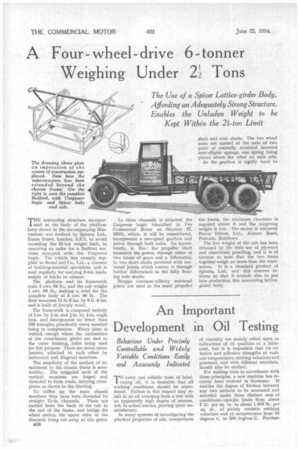An Important Development in Oil Testing
Page 38

Page 39

If you've noticed an error in this article please click here to report it so we can fix it.
Behaviour Under Precisely Controllable and Widely Variable Conditions Easily and Accurately Indicated
T0 carry out reliable tests of lubricating oil, it is desirable that all working conditions should be reproduced. Failure in this respect may result in an oil emerging from a test with an apparently high degree of success, yet, in actual service, proving quite unsatisfactory.
In many systems of investigating the physical properties of oils, comparisons of viscosity are mainly relied upon as indications of its qualities as a lubricant, but it is important that its cohesive and adhesive strengths at various temperatures, rubbing velocities and pressures, and with different materials. should also be studied.
For making tests in accordance with these principles, a new machine has recently been evolved in Germany. It enables the degree of friction between any two surfaces to be measured and recorded under three distinct sets of conditions—specific loads from about 7 lb. per sq. in. to about 1,400 lb. per sq. in., at Fvidely variable rubbing velocities and at temperatures irony 15 degrees C. to 200 degrees C. Further more, it permits wear of the test piece to be accurately determined.
The apparatus consists fundamentally of a revolving hollow drum mounted on the main shaft, and a test piece which bears upon its periphery. Provision is made for heating the drum internally, for regulating the pressure of the test piece upon it, and for measuring the temperature of the latter close to the area of contact.
The weighted beam to which the test piece is attached is mounted on a frathe, free to rock about the axis of . the main shaft against a suitable load. Thus, the friction displaces the frame from its normal position, the angular movement being indicated On a scale. The bearing surface of the test piece ran, of course, take any desired form.
The lower part of the drum is submerged in the oil under test, which is contained in a small reservoir.
In addition to measurements of friction, comparative tests can be made by ascertaining at what temperature, specific load and rubbing velocity the
oil film breaks down. The point at which the film is penetrated indicates the maximum degree of internal tenacity of the oil, and the point at which it is stripped off the surface of tha drum indicates its maximum degree of adhesion. It is also possible to test the durability. of a given quantity of lubricant
As an example of a straightforward friction test, a specimen of a certain oil, examined at temperatures varied from 100 degrees C. to 20 degrees C., at a constant bearing pressure and at speeds of 40, 214 and 440 ft. per minute, was found to show friction that, between limits, dithinished with increase of temperature and speed. At the lowest rubbing velocity, however, the friction was at a minimum at 30 degrees C., increasing at a steady rate as the drum was heated, and more rapidly as it was .further cooled.
At 214 ft. per minute, the minimum was at 6ri degrees C., a slight increase
being shown with a rise in temperature and a rapid increase with a fall. The teSt at the highest speed showed lowest friction at 100 degrees C., with hardly perceptible change to 80 de-, grees C., at which point it began to rise at an increasing rate.




























































































